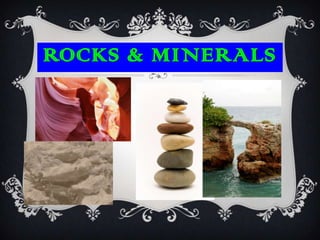
Rocks & minerals
- 2. Minerals are always solid with particles in repeating patterns- crystals They are only found in Nature. They are formed in the Earth’s mantle (from heat and pressure) – near the surface when oxygen, calcium and carbon combine in the ocean, and when hot, mineral-rich water moves slowly through the cracks in the Earth’s crust.
- 3. EXAMPLES OF MINERALS: Quartz Iron Calcite Hematite Calcite Diamond
- 4. PROPERTIES OF MINERALS: Streak: color of the powder left behind when you rub a mineral against a white tile called a streak plate. Luster: the way the surface of a mineral reflects light, either metallic (shiny) or nonmetallic (dull) Hardness: a mineral’s ability to resist being scratched as measured by Mohs’s hardness scale
- 5. USES OF MINERALS: Quartz makes glass. Diamonds make jewelry. Hematite can be used to make art. Many things that we see and use every day are made from iron.
- 6. What are three testers that can be used to determine a mineral’s hardness? fingernail, penny, nail
- 7. ROCKS: Rocks are made up of two or more minerals. They are not crystals Some rocks form near the surface while others deep in the crust. There are THREE major categories of Rocks: 1. IGNEOUS 2. SEDIMENTARY 3. METAMORPHIC
- 8. IGNEOUS ROCKS: Form when melted rocks harden Fine-grained rocks (smooth) are from lava Coarse-grained rocks (rough) are from magma. Obsidian Basalt Pumice Granite
- 9. SEDIMENTARY ROCKS: Formed from layers of sediment, created by weathering, and erosion, that are dropped from Fossil moving water, and are squeezed and stuck conglomerate rock together. Fossils are usually found in sedimentary rocks. Conglomerate rocks have large pieces and rom in shallow water Siltstone is made up of smaller pieces Limestone is made up of fine grained rock Limestone Sandstone is made up of grains the size of sand. Sandstone
- 10. METAMORPHIC ROCKS Existing rocks are changed through high heat and pressure to form different rocks morph = change Slate Schist Marble Gneiss
- 11. ROCK CYCLE Like most cycles, the materials are used over and over. Process include weathering, erosion, deposition, melting, compaction, and cementation.
